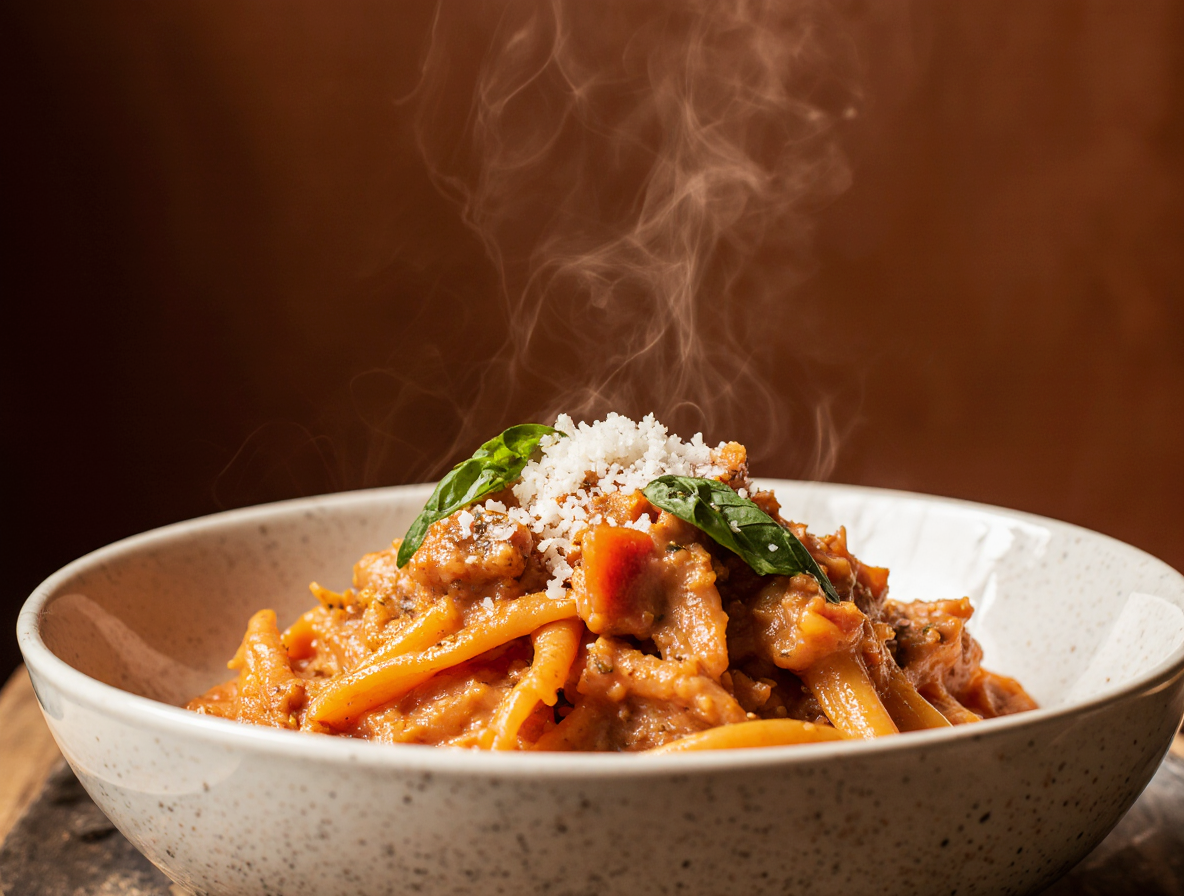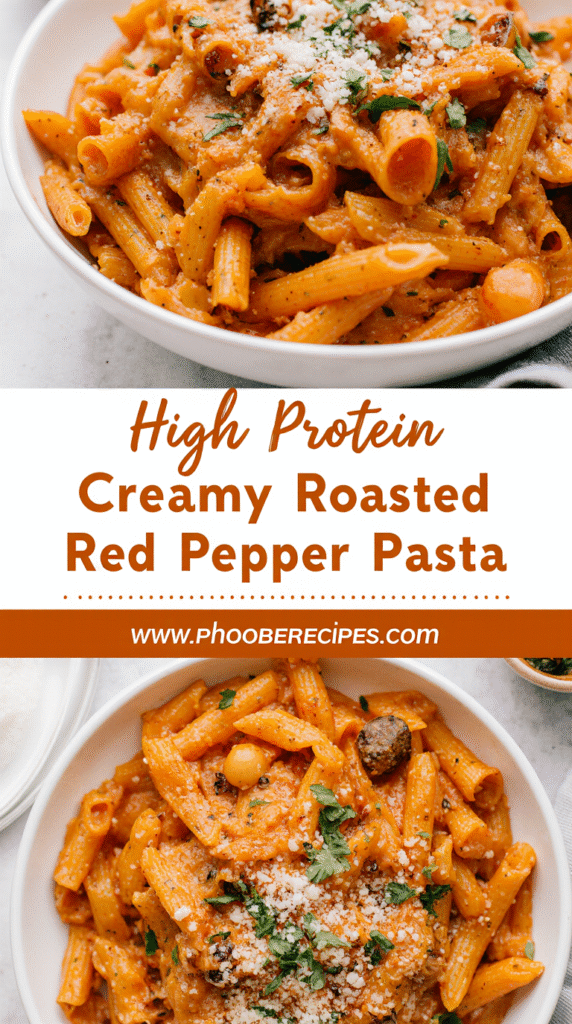The Secret to Perfect Roasted Red Pepper Pasta Sauce (High-Protein Recipe)
Craving a rich, creamy roasted red pepper pasta sauce recipe that actually boosts your protein intake? Protein keeps us full and fuels basically every bodily function, which is why I’m excited to share this deceptively nutritious pasta sauce. Surprisingly, this indulgent sauce contains over 60g of protein just from cottage cheese and silken tofu, without needing a drop of heavy cream.
This creamy roasted red pepper pasta is perfect for busy weeknights, taking only about 30 minutes to prepare. What makes this roasted pepper pasta sauce special is how it achieves that luxurious texture while being protein-packed. Instead of traditional heavy cream, it uses cottage cheese (with 11g of protein per 100g) and silken tofu to create a dreamy sauce that appeals to kids and adults alike. Throughout this article, I’ll walk you through how to make this versatile roasted red pepper pasta recipe, along with tips for customization and storage so you can enjoy this creamy red pepper pasta sauce whenever the craving strikes.
What makes this roasted red pepper pasta sauce high in protein
The secret to this protein-packed roasted red pepper pasta sauce lies in two key ingredients that create luxurious creaminess without heavy cream. Unlike traditional cream-based sauces, this recipe delivers an impressive protein boost – over 60g just from two ingredients. This makes it perfect for anyone looking to increase their protein intake without sacrificing flavor.
Cottage cheese vs. ricotta: which is better?
Cottage cheese is the protein powerhouse in this roasted red pepper pasta sauce recipe, containing approximately 11g of protein per 100g. Despite its humble appearance, cottage cheese transforms completely when blended, creating a smooth, creamy base that’s perfect for sauces.
Although ricotta is often used in Italian pasta dishes, cottage cheese offers several advantages:
- Higher protein content per serving than ricotta in many cases
- Lower calorie density than whole milk ricotta
- Tangier flavor profile that balances the sweetness of roasted red peppers
Furthermore, cottage cheese provides additional nutrients including calcium, phosphorus, selenium, and vitamin B5, which helps your body convert carbohydrates, fats, and proteins into energy. For those with lactose sensitivity, cottage cheese contains only about 3g of lactose per half-cup serving – significantly less than regular milk.
The role of silken tofu in creamy sauces
Silken tofu is the second protein hero in this creamy roasted red pepper pasta sauce. Unlike firm tofu, silken tofu has a custardy texture that blends ultra-smooth, ensuring no grainy texture in your sauce. It’s nearly flavorless, making it an excellent vehicle for absorbing the rich tastes of roasted peppers and seasonings.
Particularly beneficial for plant-based options, silken tofu creates velvety texture while contributing significant protein. Additionally, it doesn’t require refrigeration until opened, making it a convenient pantry staple.
Other protein-rich add-ins to consider
To boost the protein content of your roasted pepper pasta sauce even further, consider these additions:
- Nutritional yeast (which contains beneficial beta-glucans)
- Grilled chicken, ground turkey, or even tuna
- Plant-based proteins like mushrooms, broccoli, or green peas
The beauty of this roasted red pepper pasta recipe is its versatility – you can customize it based on your dietary preferences without compromising on the creamy texture or protein content.
Step-by-step guide to making the perfect sauce
Creating this protein-rich roasted red pepper pasta sauce is straightforward once you know the key techniques. Let me walk you through the four essential steps that transform simple ingredients into a velvety, flavor-packed sauce that clings perfectly to your pasta.
1. Roast or use jarred red peppers
For convenience, jarred roasted red peppers work wonderfully in this recipe. Simply drain them well and soak in cold water for 10-15 minutes to reduce acidity. Pat dry before using to prevent a watery sauce.
Alternatively, roast your own: Preheat oven to 425°F, slice bell peppers in half, remove seeds and stems, and place cut-side down on a foil-lined baking sheet. Roast for 35-40 minutes until skins blacken. Once charred, immediately transfer to a bowl and cover tightly with plastic wrap for 10 minutes. The steam will loosen the skins, making them easy to remove once cool enough to handle.
2. Blend with garlic, cheese, and seasonings
First, sauté garlic and shallots in butter or olive oil until fragrant (about 30 seconds for garlic, 10-15 minutes for caramelized shallots). Transfer to a food processor or blender along with the roasted peppers, cottage cheese, and seasonings like oregano, paprika, basil, and balsamic vinegar. For extra protein, add silken tofu as discussed previously. Blend until completely smooth.
3. Adjust texture with pasta water or milk
The secret to perfect sauce consistency lies in strategic liquid management. If your sauce is too thick, gradually add reserved pasta water—the starch helps the sauce cling to pasta while thinning it to the ideal consistency. Alternatively, milk works for a richer result. For protein-packed creaminess without heavy cream, a splash of pasta water mixed with the cottage cheese creates that luxurious texture.
4. Combine with pasta and heat through
Once your pasta is cooked al dente, drain it but never rinse—those surface starches are crucial. Return pasta to the pot, add the sauce, and heat everything together over low heat. This final cooking stage is critical; it allows the pasta to absorb the sauce’s flavors while the sauce thickens and clings to every strand. Add pasta water as needed to maintain the perfect “nappé” consistency—just thick enough to coat the back of a spoon.
Tips to enhance flavor and texture
The difference between good and great roasted red pepper pasta sauce often comes down to a few simple techniques. First and foremost, these tips will elevate both flavor and texture without compromising the protein benefits we’ve discussed.
Use fresh herbs like basil or parsley
Fresh herbs make a remarkable difference in your roasted red pepper pasta sauce recipe. I strongly recommend using fresh basil rather than dried for the best possible flavors. The lemon juice and fresh basil combination rounds out the depth of flavor beautifully. For garnishing, chopped basil and pine nuts add visual appeal and flavor complexity. If basil isn’t available, fresh flat-leaf parsley works wonderfully as an alternative. Moreover, fresh herbs take the flavor up several notches compared to their dried counterparts.
Don’t skip the garlic sauté step
Sautéing garlic properly is crucial for developing rich flavor in your creamy roasted red pepper pasta. Heat butter or olive oil over medium-low heat and add minced garlic, cooking just until soft but not browned. This step creates layers of complexity as the garlic releases its natural oils. Consequently, the garlic becomes sweet rather than sharp. Remember that garlic can burn quickly, so keep stirring frequently and remove from heat as soon as it turns golden brown.
How to avoid grainy or lumpy sauce
“Clumpy” isn’t a word you’d use to describe perfect pasta sauce—”smooth” or “velvety” sounds right. To prevent a grainy texture, blend ingredients thoroughly until completely smooth. Overheating cheese sauce can cause it to “break,” resulting in a grainy consistency. Similarly, using pre-shredded cheese (coated with anti-caking agents) can cause graininess. Always use freshly grated cheese for the smoothest result. Additionally, if adding flour to thicken, incorporate it gradually while constantly stirring.
Balancing acidity with balsamic vinegar
Balsamic vinegar introduces acidity and complexity that perfectly balances the sweet notes from roasted peppers. This balancing act is essential—if your sauce tastes too tangy, adding ⅛ teaspoon of white sugar can help. Balsamic vinegar adds a caramel-like sweetness and umami that rounds out all the flavors in your roasted pepper pasta sauce. In fact, this simple addition transforms an ordinary sauce into something memorable.
How to store, reheat, and customize your pasta
Proper storage and reheating techniques allow you to enjoy your protein-packed roasted red pepper pasta sauce beyond just one meal. Mastering these methods ensures the sauce maintains its creamy texture and rich flavor profile whenever you’re ready to indulge.
Storage tips for fridge and freezer
Store your roasted red pepper pasta sauce in an airtight container in the refrigerator for up to 3-5 days. For optimal results, keep the sauce separate from the pasta to prevent the noodles from absorbing too much liquid and becoming soggy.
When freezing, cool the sauce completely first, then transfer to freezer-safe containers or ziplock bags (spread flat with excess air removed). The sauce can be safely frozen for up to 3-4 months[183]. Label containers with contents and date to track freshness.
Reheating without losing creaminess
The key to reheating creamy sauces is low, gentle heat to prevent separation. On the stovetop (best method), warm the sauce over medium-low heat, stirring frequently and adding a splash of milk or pasta water to restore creaminess.
For oven reheating, place in a covered baking dish at 350°F for about 30 minutes. Alternatively, use a microwave on low power in one-minute intervals, stirring between each, and adding liquid as needed.
Add-ins: grilled chicken, tofu, or veggies
Transform your roasted red pepper pasta into a complete meal with protein-rich additions like seared chicken, crispy tofu, or white beans. For vegetables, try:
- Cherry tomatoes (roasted for extra flavor)
- Leafy greens like spinach (simply wilt in the hot pasta)
- Broccoli, zucchini, or peas for added nutrients
For enhanced flavor, consider adding a tablespoon of red pepper paste or a splash of balsamic vinegar.
Make it vegan or nut-free
Creating a vegan version is straightforward—substitute cottage cheese with vegan cream cheese and omit the parmesan. The silken tofu mentioned earlier provides excellent creaminess without dairy. Nutritional yeast creates a cheesy flavor while remaining plant-based.
For nut allergies, ensure all ingredients are sourced from nut-free facilities. This protein-rich sauce is naturally nut-free when made with cottage cheese and tofu, making it suitable for most dietary restrictions.
Conclusion
Undoubtedly, this roasted red pepper pasta sauce recipe offers the perfect blend of indulgence and nutrition. Throughout this article, I’ve shown how cottage cheese and silken tofu work together to create a creamy, protein-packed sauce without heavy cream. The 60+ grams of protein make this dish satisfying while the quick 30-minute preparation fits perfectly into busy weeknight schedules.
Most importantly, you don’t need to sacrifice flavor for nutrition. Fresh herbs, properly sautéed garlic, and that touch of balsamic vinegar transform simple ingredients into a restaurant-worthy sauce. The versatility of this recipe allows endless customization based on your preferences and dietary needs.
Lastly, proper storage techniques ensure you can enjoy this delicious sauce beyond just one meal. Whether refrigerated for a few days or frozen for months, you’ll always have a protein-rich option ready when hunger strikes.
This roasted red pepper pasta sauce proves comfort food can actually nourish your body. Give this recipe a try next time you crave pasta – your taste buds and muscles will thank you equally!
FAQs
Q1. How does this roasted red pepper pasta sauce achieve high protein content? This sauce gets its protein boost from cottage cheese and silken tofu, providing over 60g of protein without using heavy cream. These ingredients create a creamy texture while significantly increasing the protein content.
Q2. Can I make this sauce vegan? Yes, you can make a vegan version by substituting cottage cheese with vegan cream cheese and omitting the parmesan. Silken tofu provides creaminess, while nutritional yeast can add a cheesy flavor while keeping it plant-based.
Q3. How long can I store the roasted red pepper pasta sauce? You can store the sauce in an airtight container in the refrigerator for 3-5 days. For longer storage, you can freeze it for up to 3-4 months. Always cool the sauce completely before freezing.
Q4. What’s the best way to reheat the sauce without losing its creaminess? The best method is to reheat the sauce on the stovetop over medium-low heat, stirring frequently. Add a splash of milk or pasta water to restore creaminess. Alternatively, you can use the oven or microwave, but be sure to use low heat and stir often.
Q5. How can I enhance the flavor of the roasted red pepper pasta sauce? To enhance flavor, use fresh herbs like basil or parsley, don’t skip sautéing the garlic, and consider adding a splash of balsamic vinegar. You can also customize by adding grilled chicken, tofu, or vegetables like cherry tomatoes or spinach.


